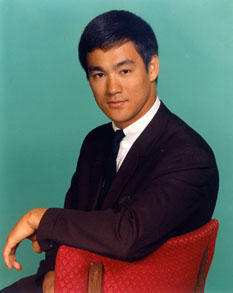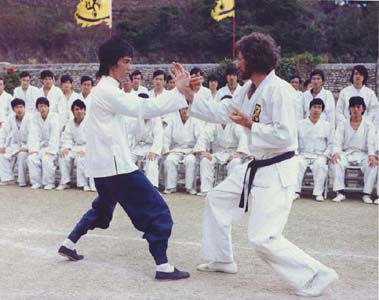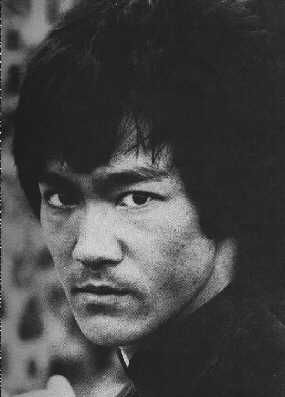 He
is considered by his peers to be the greatest
fighter of the twentieth century, and quite
possibly ever. To the world he was an action
movie star. To his students and disciples he was
a teacher who was gifted with an extraordinary
philosophical mind that he brought to bear, not
only in his martial arts training, but also in
his life and how he lived it. He
is considered by his peers to be the greatest
fighter of the twentieth century, and quite
possibly ever. To the world he was an action
movie star. To his students and disciples he was
a teacher who was gifted with an extraordinary
philosophical mind that he brought to bear, not
only in his martial arts training, but also in
his life and how he lived it.
Bruce Lee was born in San
Francisco in 1940, in the Chinese year of the
dragon. His father was a Chinese actor touring
with the Canton Opera. As a child growing up in
Hong Kong, Bruce was exposed to Tai Chi Chuan by
his father, who practiced it for his health.
Though he learned very little fighting skills
from his father, this was the first exposure
Bruce Lee had to Taoist concepts.
By his teenage years Lee had
begun to get in trouble. The streets of post-war
Hong Kong were rough filled with gangs and
violence. Triads were a constant threat. After
several serious incidents, Lee's parents agreed
to enroll him in gung fu classes.
At the age of thirteen Lee
was accepted into the kwoon (training hall) of
renowned Sifu Yip Man, the head of the Wing Chun
school. Under Yip Man's tutelage, he began to
study the Wing Chun style of fighting as well as
the philosophical underpinnings, which Yip Man
greatly stressed.
Wrote Lee's widow, Linda:
"If there is anything that Yip Man gave to
Bruce which may have crystallized Bruce's
direction in life, it was to interest his student
in the philosophical teachings of Buddha,
Confucius, Lao Tzu, and other great thinkers and
philosophers. As a result, Bruce's mind became
the distillation of the wisdom of such teachers,
specifically, but not exclusively, the deep
teachings of the yin/yang principle."
.
|
 At
the age of eighteen, Lee's parents sent him to
America to get him away from the gangs and
violence of Hong Kong. Lee settled in Seattle and
stayed with family friend Ruby Chow, who owned a
restaurant. They often clashed, as Lee refused to
show Chow the elder piety that she felt was due
her under Confucian tradition. While working at
her restaurant he attended Edison technical
School and earned his high school diploma. At
the age of eighteen, Lee's parents sent him to
America to get him away from the gangs and
violence of Hong Kong. Lee settled in Seattle and
stayed with family friend Ruby Chow, who owned a
restaurant. They often clashed, as Lee refused to
show Chow the elder piety that she felt was due
her under Confucian tradition. While working at
her restaurant he attended Edison technical
School and earned his high school diploma.
He quickly developed a
reputation for his gung fu skills and soon had
many people wanting to study under the gifted
nineteen year-old. One of those people, Taky
Kimura, a thirty-eight year-old
Japanese-American, had been in the United States
internment camp during World War II, and suffered
difficulty in getting a decent job afterward,
under the shadow of post-war anti-Japanese
sentiment. Demoralized, Kimura was seeking
something to give him back his self-confidence.
He found that in the young Bruce Lee, who became
his mentor, spiritual guide, and best friend.
Lee went on to the
University of Washington at Seattle where he
majored in philosophy. His grasp of Eastern
concepts was so profound that he became in great
demand as a lecturer on Eastern philosophy.
Lee had avoided setting up a
school of gung fu in Seattle because he wanted to
focus on his education. But, not liking the jobs
he had to do to support himself, he finally
opened one near the university in late 1963. As
he had never achieved instructor rank in Wing
Chun gung fu, he christened his school the Jun
Fan Gung Fu Institute, after his Chinese name.
Bruce Lee was already
beginning to feel discontent with
"styles" of fighting. On the separation
between hard and soft styles of gung fu schools
he said: "It's an illusion. You see, in
reality gentleness/firmness is one inseparable
force of one unceasing interplay of movement. We
hear a lot of teachers claiming their styles are
either soft or hard; these people are clinging
blindly to one partial view of the totality. I
was once asked by a so-called 'kung fu
master'-one of those that really looked the part
with the beard and all-as to what I thought of
Yin and Yang? I simply answered, 'Baloney!' Of
course, he was quite shocked at my answer and
could not come to the realization that 'it' is
never two." Lee understood the false
division that so often traps students of Taoism,
the false division in recognizing Yin and Yang as
opposites, and not as complements.
Lee quit the university and
married Linda Emery. After the wedding, the two
moved to California, where Lee opened another
school. Within a short time Lee had caught the
attention of San Francisco's Chinatown. They were
upset by Lee's practice of teaching the arts to
non-Chinese. For his part, Lee believed that all
humanity was a totality, and did not make the
distinction between races. "Under the sky,
under the heavens, there is but one family."
One day a group of Chinatown
Kung Fu men appeared at Lee's kwoon demanding
that he stop teaching the "gwei-lo" or
foreign devils at once or he would have to fight
their top fighter, Wong Jack Man. Thinking him a
paper tiger, they were startled when he accepted.
When they tried to impose rules and a date for
the fight Lee became angry, saying the fight
would take place immediately and without rules.
His opponent had no choice but to agree.
Lee and Wong Jack Man then
formally bowed and began to fight. Lee fought in
strict Wing Chun style and, combined with Wong
Jack Man's own style, the two seemed to cancel
each other out. After three minutes, Lee finally
managed to put Wong Jack Man on the floor and
forced him to submit.
Though Lee's victory ended
his problems with the Chinatown community, he was
very unhappy with how the fight went. He found
that his style of fighting had held him back; a
fight he should have won easily in a few seconds
took three minutes and a narrow victory. He
realized that he must continue to evolve. The
idea of styles of fighting had come into conflict
with his Taoist beliefs that the way of fighting
is formless and all-encompassing, and that styles
separate the fighter from the truth.
.
|
 It
was at this point that Bruce's expression of
martial arts and philosophy, Jeet
Kune Do, was born. Its chief
principle of "having no way as way"
borrowed heavily from Lao Tzu, "This is
called shape without shape, form without
object." It
was at this point that Bruce's expression of
martial arts and philosophy, Jeet
Kune Do, was born. Its chief
principle of "having no way as way"
borrowed heavily from Lao Tzu, "This is
called shape without shape, form without
object."
Soon Bruce began to study
other styles; he adopted footwork from fencing
and some hand strikes from western boxing, to
name a few. His philosophy was to "absorb
what is useful, discard what is useless, and add
what is essentially one's own." By November
1966 Bruce had a clear idea of his new vision for
fighting. In 1967 he coined the name Jeet
Kune Do to represent his
personal expression of the martial arts. He then
designed a symbol for Jeet Kune Do that consisted
of the Tai Chi symbol with two arrows around it
moving in opposite directions. This implied the
constant interchange between yin and yang. Within
a few years he was the top martial artist in the
world, attracting as students top fighters such
as Chuck Norris and Joe Lewis; and such celebrity
students as Steve McQueen, James Coburn, Blake
Edwards and Kareem Abdul-Jabbar.
Bruce was trying to instill
in his students the natural spontaneity of
combat, to reach a point where the action becomes
thoughtless, where there is no separation between
the fighter and the fight. Lee believed that all
knowledge led to self-knowledge, and that he
could not teach his students so much as point
them in the direction of knowledge. "I
cannot teach you, " Bruce mused to James
Franciscus in the television series Longstreet,
"only help you to explore yourself."
Bruce did not believe in
learning by accumulation, but instead believed
that the highest form of mastery was one of
simplicity, of "stripping away the
inessentials", much like Lao Tzu believed in
the need to disband all schools of formal
learning. Indeed, Bruce disbanded his own school
system shortly before his death, lest his way be
taken as "the Way".
Soon after Lee got his own
break in Hollywood as Kato on the Green
Hornet series. It earned him
great popularity but folded after only one
season.
An offer by Raymond Chow's
Golden Harvest Studio in Hong Kong brought Lee
back to Asia to make the movie the Big
Boss. When the movie came
out, Lee became an overnight sensation throughout
Asia. Two more films followed: Fists
of Fury and
Way of the Dragon. In the
movie Way of the Dragon,
Lee demonstrates the Taoist principle of
adaptability in his climactic fight scene with
Chuck Norris. Having fought to a virtual
standstill, Lee begins to adapt his fighting
method from one of rigidity to one of pliancy,
and emerges the victor.
His fourth picture was
intended to further expound upon the theory of
flexibility as a means of survival. Entitled Game
of Death, the movie, as
conceived by Bruce Lee, would have begun like
this: "As the film opens we see a wide
expanse of snow. Then the camera closes in on a
clump of trees while the sounds of a strong gale
fill the screen. There is a huge tree in the
center of the screen, and it is all covered with
thick snow. Suddenly there is a loud snap, and a
huge branch of the tree falls to the ground. It
cannot yield to the force of the snow so it
breaks. Then the camera moves to a willow tree
which bending with the wind. Because it adapts to
the environment, the willow survives. What I want
to say is that a man has to be flexible and
adaptable, other wise he will be destroyed."
Though the movie was begun, Lee never finished
it, and the Game of Death that
reached theaters bore little resemblance to Lee's
original vision.
In 1972 Warner Brothers
approached Lee to make a movie for American
audiences. In the movie, Enter
the Dragon, Lee tried to
express some of his philosophy. In an early scene
in the film he discusses a sparring match with an
old Taoist priest. When the priest asks Lee what
he thought of his opponent when he was facing
him, Lee replies, "There is no opponent.
Because the word 'I' does not exist." The
priest is very pleased by his answer. This scene
was cut out of the American version because the
producers thought American audiences would be
turned off by all the philosophy mumbo jumbo.
Through it all he was still
teacher and guide to his friends. At the time he
was filming Enter the Dragon,
Bruce's friend Taky Kimura called him from the
United States with a personal crisis: Kimura's
marriage was falling apart and he was despondent
and suicidal. "I lost two brothers a month
apart and then my wife left me," said
Kimura.
Bruce told him, "Taky,
I haven't met your wife but I've counseled you
before. You must do everything in your power to
solve the thing but, at some point in time, you
may just have to walk on." Bruce was saying
that if nature dictated that the marriage was
over, going against it would only bring further
unhappiness. Bruce was expressing the Taoist
philosophy of wu-wei,
or following the course of nature without
resisting it. "Walk on," he would tell
Kimura, "walk on."
"Life is an
ever-flowing process and somewhere on the path
some unpleasant things will pop up-it might leave
a scar-but then life is flowing on, and like
running water, when it stops, it grows stale. Go
bravely on, my friend, because each experience
teaches us a lesson."
On July 20, 1973, Bruce Lee
died of a cerebral edema, three weeks before the
opening of Enter the Dragon,
three weeks before he would gain worldwide fame.
Lee was buried at Lakeview
Cemetery in Seattle, Washington. The casket was
covered in white, red, and yellow flowers making
up the yin/yang symbol. The pallbearers were
Steve McQueen, James Coburn, Bruce's brother
Robert, and Bruce's top student, Dan Inosanto. At
the graveside James Coburn had the last words:
Farewell, brother. It has been an honor to share
this space with you. As a friend and a teacher,
you have given to me, have brought my physical,
spiritual, and psychological selves together.
Thank you. May peace be with you."
On his tombstone was
engraved the message: "Your inspiration
continues to guide us toward our personal
liberation." His gravesite has been
faithfully cared for by his friend and student
Taky Kimura for the past twenty-five years.
|